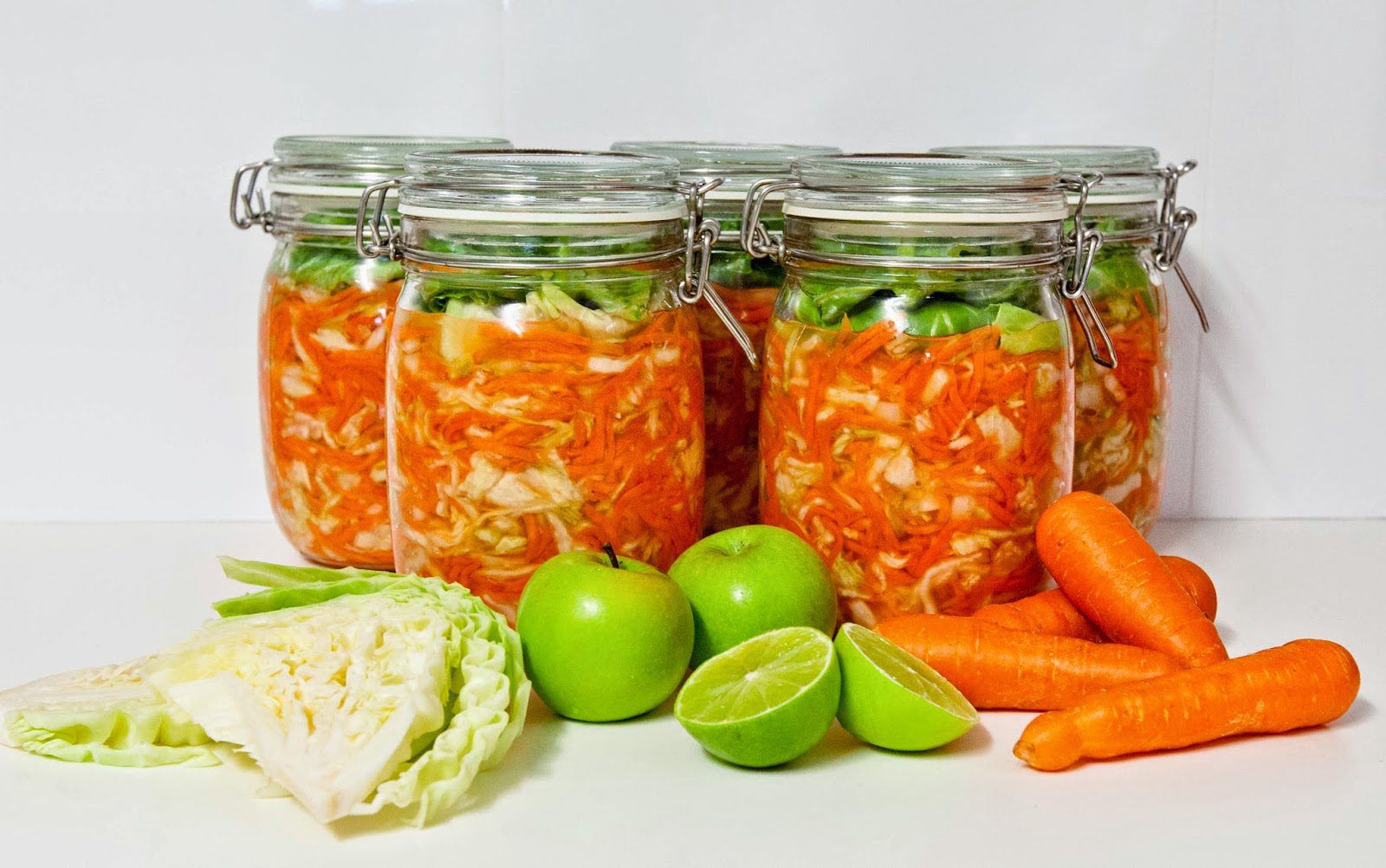
Fermented Cabbage & Carrot (Pickled, Sauerkraut)
This basic fermented Cabbage and Carrot with green apple and lime juice is a staple in our house. I add it to almost everything and try and include it at least twie a day. I use it as a side with our meals including savoury breakkies, mixed through our salads, with lettuce wraps, chopped finely into some guacamole or sometimes on its own (I love the sourness and crunchy texture).
It is really simple to make and can easily replace your need to buy expensive probiotics. Including fermented veggies in our daily diet has been so beneficial to us and especially for my children. It can help with sugar cravings, bloating, recurrent sore tummies, healing the gut (from overuse of antibiotics) which also can help with symptoms like ADHD and tics. All of these symptoms were present in my children and have been dramatically reduced. I cannot recommend it enough!
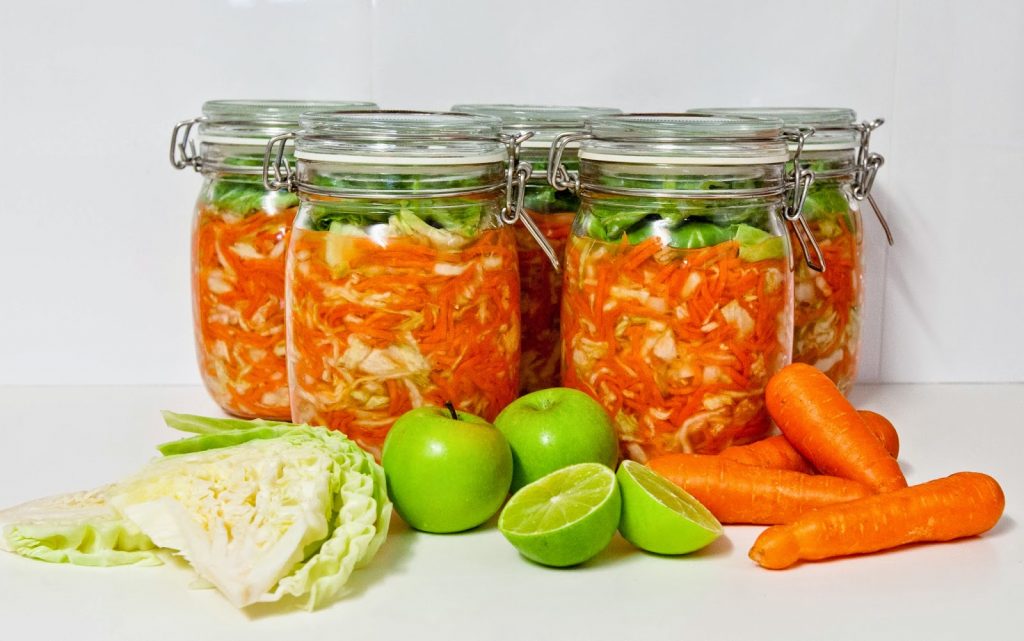 |
| Fermented Cabbage & Carrots with Green apple and lime juice |
This recipe should make approximately 5 x 1 Litre (equivalent to 1 quart almost) Jars.
I like to use a Starter Culture to ensure the batch as all the right bacteria to start with, this was especially important for me as I needed to heal my son’s gut from overuse of antibiotics. I use Body Ecology Veggie Starter Culture which you can buy here.
PS. If you live in Australia, you can order your Body Ecology products from here. Enter discount code ‘loveurbelly’ for 5% off.
Also try and use organic veggies if possible.
For this recipe, it is also optional to ferment the leftover carrot tops which I normally do, they are great tossed through salads or just to snack on.
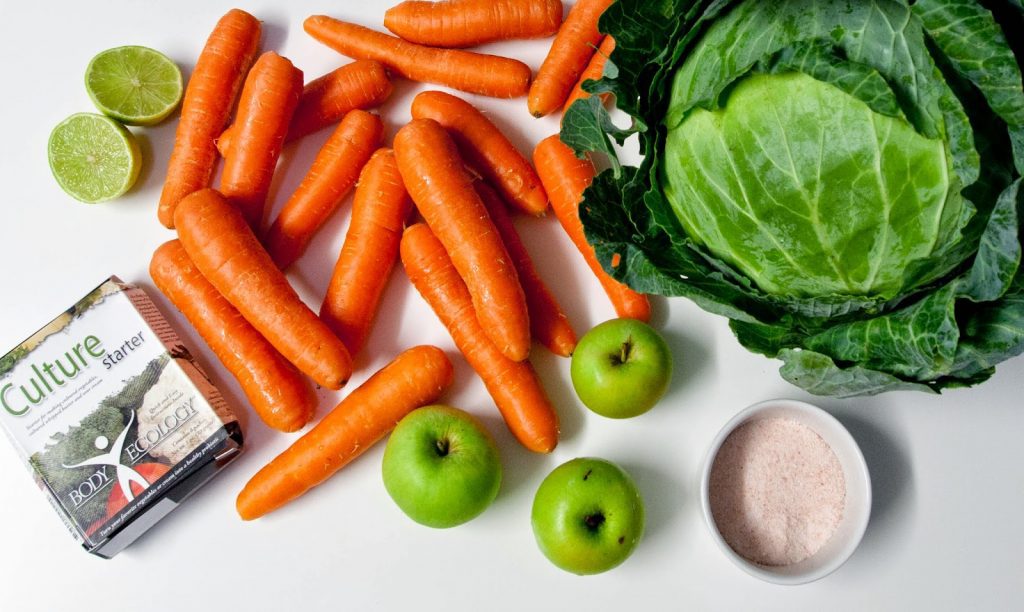 |
| Everything you need to ferment your own cabbage and carrots |
You will need:
- 5 x 1 Litre (or 1 Quart approx) flip top jars plus 1 smaller flip top jar (for the carrot tops – this is optional)
- 1 satchet Body Ecology Veggie Starter Culture (or add extra 1 tbsp salt)
- 1 whole large cabbage approx 2kg (approx 4.4lbs)
- 2kg carrots (approx 4.4lbs)
- 2 green apples
- Juice of one lime or lemon
- 1-2 tsp salt or 2-3 tbsp salt if not using a culture starter
- filtered water approx 500ml to 1 litre (half to 1 quart) left at room temperature
- Take out the Culture starter satchet and allow to come to room temperature
- Wash all the jars, rubber seals in hot soapy water and rinse really well (soap residue is not good, so make sure to rinse really well)
- Set the jars in a dish rack or on a clean fresh tea towel to air dry
- Remove the outer leaves of the whole cabbage, you will need about 10 leaves plus 2 more if fermenting the leftover carrot bits (if the leaves are small, remove 15 outer leaves plus 2 more for the small jar)
- Wash them very carefully, especially at the base to remove any dirt etc
- Sit them on a clean fresh tea towel to air dry
- Chop or shred the cabbage using a food processor or a knife depending on your preference. I like to hand slice them by cutting the cabbage into 8 wedges and then thinly slicing them
- Add the cabbage to a very large mixing bowl
- Peel and grate the carrots using a mandolin, grater or food processor. I like my carrots thicker so I use a mandolin – careful not to cut yourself!
- Add the left over carrot bits to the smaller flip top jar (if using), you can also ferment these chunks of leftover carrots otherwise save them for some carrot soup! no waste!

- Add the carrot to the cabbage
- Grate the green apple and add to the mixing bowl
- Then add the lime juice and salt to the veggies
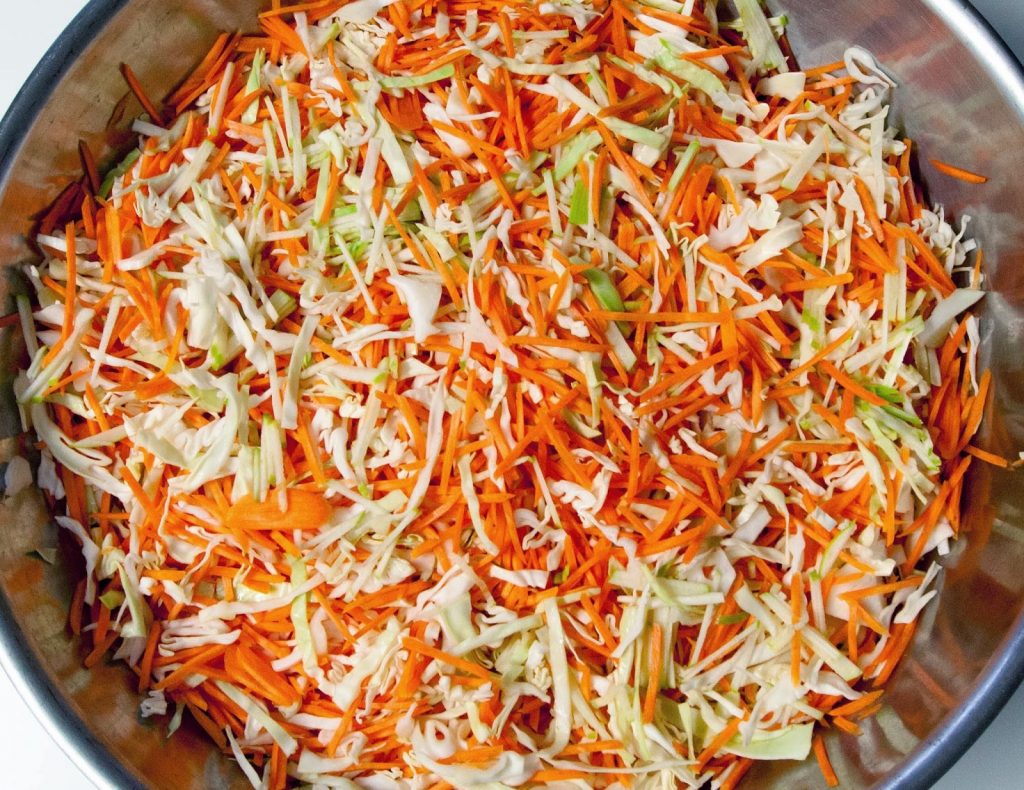
- In a glass jug, add the 500ml of room temperature filtered water with the starter culture and stir to dissolve, set aside
- Using your hands, mix and massage the veggies until the juices start to come out (I do this for about 10 mins)
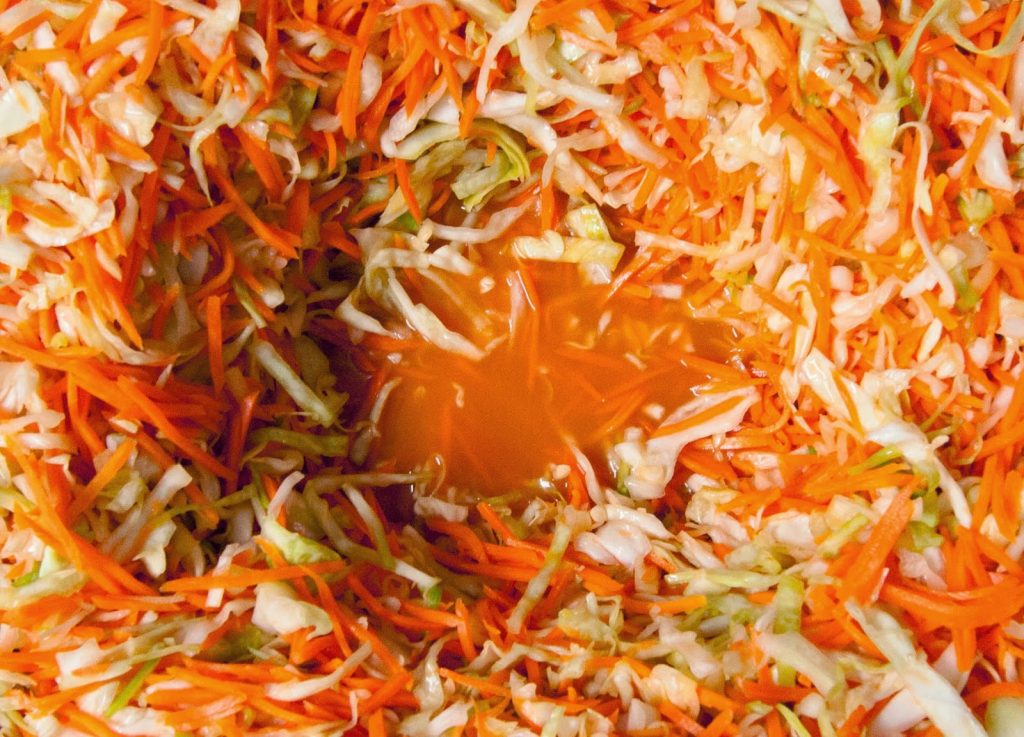
- Add the water & culture starter mixture to the veggies and mix it further
- Divide the veggies into the 5 jars and pack them down firmly with your hands or potato masher
- Include the juices / brine and ensure that it just covers the veggies (the veggies will be pushed down by the cabbage leaves which will bring the juices up further, careful not to overfill as it will result in some leakage during fermentation)
- There will most likely be some juices / brine leftover which you can use to ferment the leftover carrot pieces
- Leave about an inch from the top of the jar

- Roll 2 clean outer leaves place onto the top of the veggies (if the leaves are small, use 3) for each jar
- This should firmly pack down the veggies under the brine
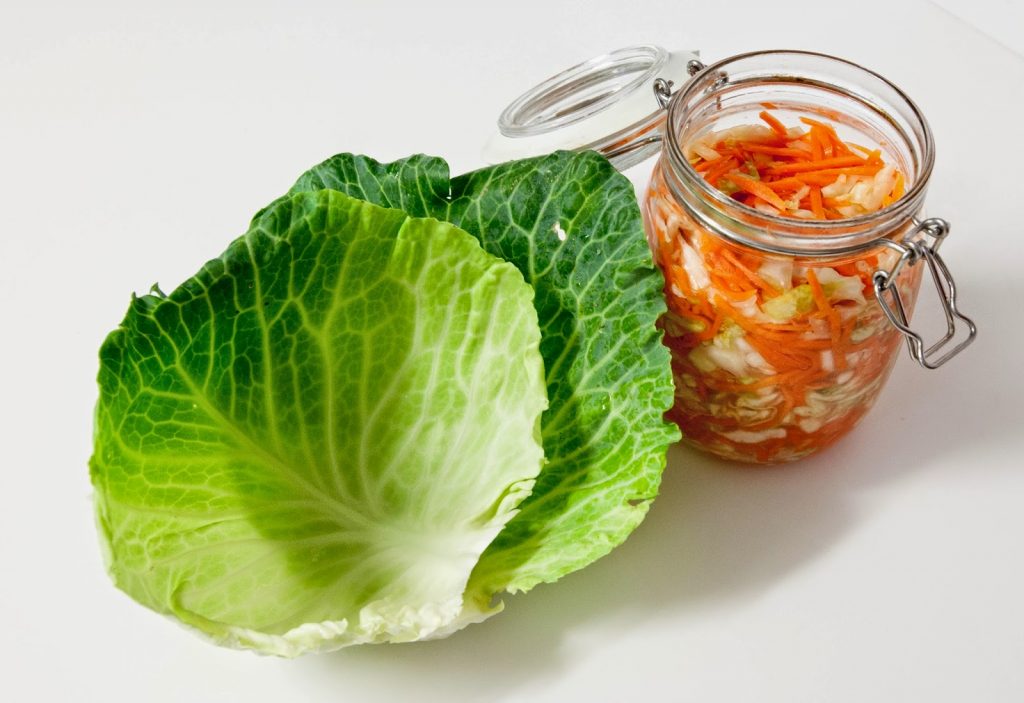
- They should now look like this
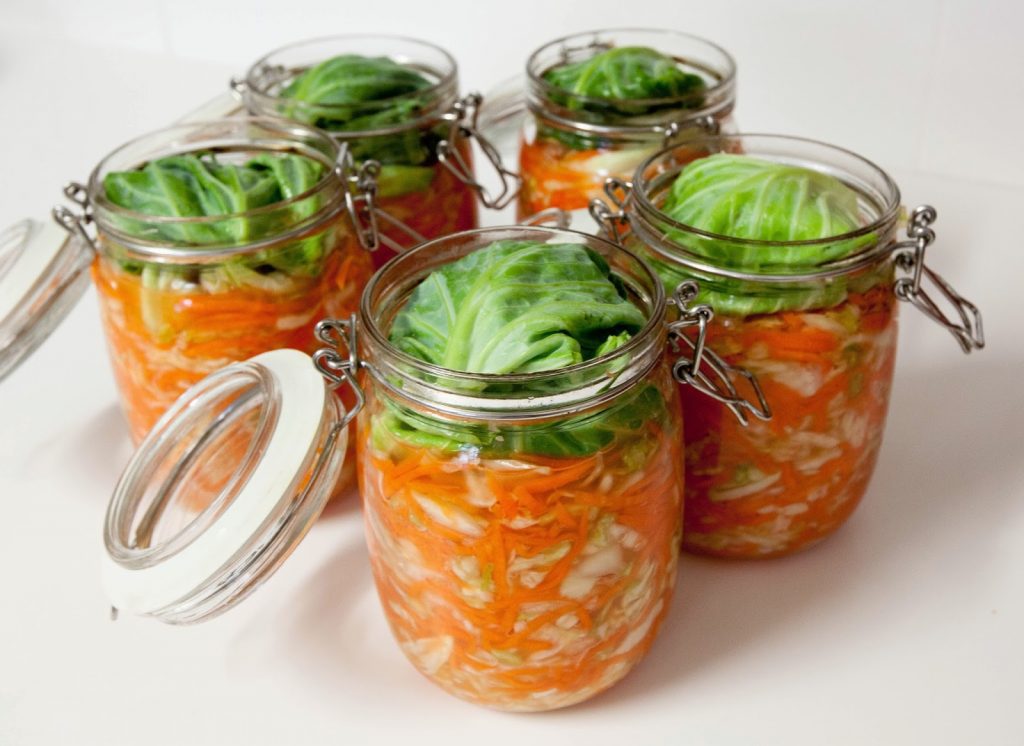
- Close the lids and store them at room temperature out of direct sunlight
- If you are fermenting the left over carrot pieces, pour the remaining juice/brine into the jar so the carrots are covered. Top it up if needed with some filtered water and a tsp of salt, then cover it up with 2 rolled cabbage leaves
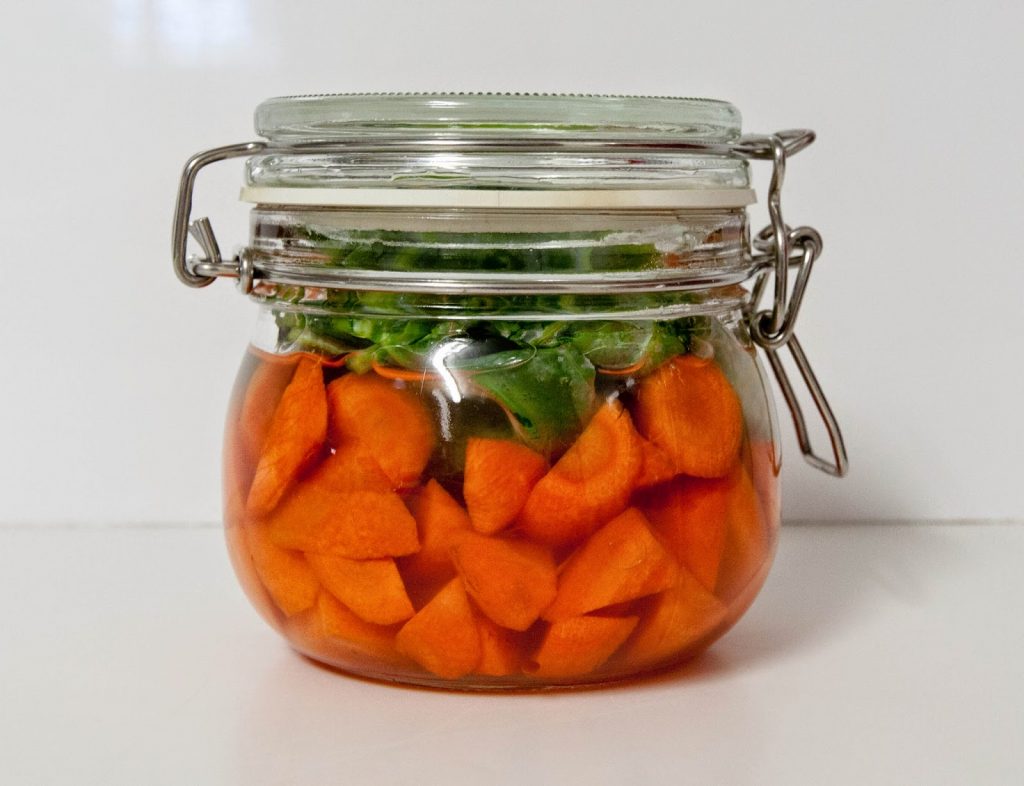
- They should be ready in 5 days if you used a starter culture, if not, wait 7-10 days
- Once opened, store in the fridge
- The unopened jars can remain at room temperature for many months
- Hope you enjoy!
Have a look under Fermented foods in the Recipe Index for other recipes!
- Store the veggies on the counter out of direct sunlight or in the pantry cupboard until needed, there is no need to store in the fridge, as traditionally, before refrigeration this is how many cultures preserved their veggies. It should keep for months.
- Only once opened, store the jar in the fridge and always use clean utensils to pick from the jar
- Using flip top glass jars with rubber seals like the one’s pictured, creates an airtight seal so air cannot get in, but allows gas to escape, so it’s normal to hear hissing sounds and a good indication the fermentation process is happening
- There is no need to open and ‘burp’ the jars as the rubber seals allow the gases to escape, it’s best to leave them alone until day 5 at least
- You should also get no mould with this method, and personally I would throw out any batch with mould just as you would throw out mouldy Kombucha (just my personal preference, I have seen variations where mould is acceptable and to just scrape it off) – I had mould once, and the veggies smelt awful, totally different to the ‘fermented’ smell. This was because I didn’t realise the rim of the glass jar had a chip in it and had allowed some air in so it was no longer airtight
- Do not stack them on top of each other as this will prevent the air from escaping and can cause the jars to explode
- The jars may leak so if storing in the pantry, sit them on a dish to catch any liquids.
- If it’s your first time, start slowly with about a small tablespoon once a day and gradually increase the amount and frequency
- It can cause excessive gas and bloating depending on whats going inside your belly if you have too much too early on
- I like to add fermented veggies to my salads or as a small side to every meal
- To introduce it to young children, try chopping about a tablespoon very finely and mixing it with half a mashed avocado, squeeze of lemon juice & some salt to make a simple guacamole, this is how my son had his first dose of fermented carrots
- Don’t cook the fermented veggies or add it to hot food as the heat will kill the live bacteria (warm food should be ok if you eat it immediately), you can mix it with any cool food or as a side to your meal
- 5 x 1 Litre (or 1 Quart approx) flip top jars plus 1 smaller flip top jar (for the carrot tops - this is optional)
- 1 satchet Body Ecology Veggie Starter Culture (or add extra 1 tbsp salt)
- 1 whole large cabbage approx 2kg (approx 4.4lbs)
- 2kg carrots (approx 4.4lbs)
- 2 green apples
- Juice of one lime or lemon
- 1-2 tsp salt or 2-3 tbsp salt if not using a culture starter
- filtered water approx 500ml to 1 litre (half to 1 quart) left at room temperature
- Take out the Culture starter satchet and allow to come to room temperature
- Wash all the jars, rubber seals in hot soapy water and rinse really well (soap residue is not good, so make sure to rinse really well)
- Set the jars in a dish rack or on a clean fresh tea towel to air dry
- Remove the outer leaves of the whole cabbage, you will need about 10 leaves plus 2 more if fermenting the leftover carrot bits (if the leaves are small, remove 15 outer leaves plus 2 more for the small jar)
- Wash them very carefully, especially at the base to remove any dirt etc
- Sit them on a clean fresh tea towel to air dry
- Chop or shred the cabbage using a food processor or a knife depending on your preference. I like to hand slice them by cutting the cabbage into 8 wedges and then thinly slicing them
- Add the cabbage to a very large mixing bowl
- Peel and grate the carrots using a mandolin, grater or food processor. I like my carrots thicker so I use a mandolin - careful not to cut yourself!
- Add the left over carrot bits to the smaller flip top jar (if using), you can also ferment these chunks of leftover carrots otherwise save them for some carrot soup! no waste!
- Add the carrot to the cabbage
- Grate the green apple and add to the mixing bowl
- Then add the lime juice and salt to the veggies
- In a glass jug, add the 500ml of room temperature filtered water with the starter culture and stir to dissolve, set aside
- Using your hands, mix and massage the veggies until the juices start to come out (I do this for about 10 mins)
- Add the water & culture starter mixture to the veggies and mix it further
- Divide the veggies into the 5 jars and pack them down firmly with your hands or potato masher
- Include the juices / brine and ensure that it just covers the veggies (the veggies will be pushed down by the cabbage leaves which will bring the juices up further, careful not to overfill as it will result in some leakage during fermentation)
- There will most likely be some juices / brine leftover which you can use to ferment the leftover carrot pieces
- Leave about an inch from the top of the jar
- Roll 2 clean outer leaves place onto the top of the veggies (if the leaves are small, use 3) for each jar
- This should firmly pack down the veggies under the brine
- They should now look like this
- Close the lids and store them at room temperature out of direct sunlight
- If you are fermenting the left over carrot pieces, pour the remaining juice/brine into the jar so the carrots are covered. Top it up if needed with some filtered water and a tsp of salt, then cover it up with 2 rolled cabbage leaves
- They should be ready in 5 days if you used a starter culture, if not, wait 7-10 days
- Once opened, store in the fridge
- The unopened jars can remain at room temperature for many months
- Hope you enjoy!




